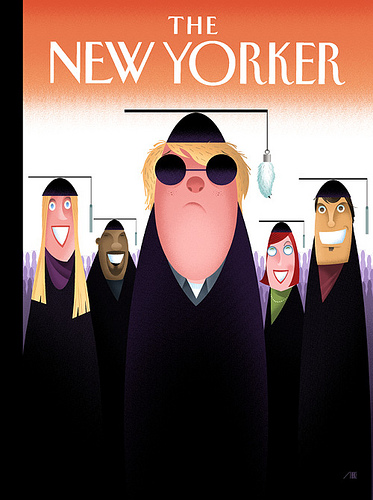A staff position at The New Yorker is the best journalistic job in the world. Elizabeth Kolbert, a very good writer and reporter, has one of them. In the current issue, criticizing Superfreakonomics, she writes:
To be skeptical of climate models and credulous about things like carbon-eating trees and cloudmaking machinery and hoses that shoot sulfur into the sky is to replace a faith in science with a belief in science fiction.
I cannot discuss engineering (“carbon-eating trees”, etc.) but I can discuss science (“climate models”). Here Kolbert shows the same limitation that practically every science journalist shows (the big exceptions are Gary Taubes and John Crewdson): They take the consensus view too seriously. In case after case — so many that it’s hard not to draw sweeping conclusions — the consensus view about difficult topics is more fragile than an outsider would ever guess. It’s not necessarily wrong, just less certain.
Kolbert places too much faith in those climate models. Here are three things Kolbert doesn’t know:
1. For years, as I’ve blogged, Leonard Syme, an epidemiology prof at Berkeley, taught his students to distrust one mainstream public-health conclusion after another. Maybe 12 examples in all. He showed them facts they didn’t know. All of a sudden the picture wasn’t so clear any more. That he could do this in so many cases, one case per week, is what’s telling.
2. If you believe mainstream ideas about weight control, the Shangri-La Diet is absurd. It can’t possibly work. Since it has actually worked in countless cases — more than half the time, as far as I can judge — the experts, it appears, got it utterly wrong. Long before me, Michel Cabanac, a professor of physiology at Laval University, was saying the same thing — that the consensus view about how to lose weight was wrong. No matter how many millions of times journalists repeated it. The Shangri-La Diet merely makes it vividly clear he was right.
3. Hal Pashler and I wrote a paper about how mental models based on fitting data were delusional. The data that supposedly supported them did not. To take seriously a model because it could fit data was a mistake, we pointed out; what matters is correct predictions. It isn’t easy to figure out the predictions of a model with many adjustable parameters; and the modelers in these cases never did. These models were accepted professionally for half a century; perhaps they still are.
It is possible that climate modelers have a different psychology than scientists in other areas — that the evidence for the consensus presented to outsiders is as strong as the scientists involved say it is — but it seems highly unlikely. For example, I doubt the climate models Kolbert places such faith in have been tested (their predictions, not just their fits, compared with reality).
There’s no doubt that carbon dioxide concentration and global temperature are correlated, but you may not know that carbon dioxide concentration lagged temperature for a long time. Because of this, I’m sure the temperature change caused the carbon-dioxide change. It isn’t mysterious; as water changes temperature, the amount of carbon dioxide it can dissolve changes. As water heats, carbon dioxide is released into the air.
This means that something powerful — not carbon dioxide — has been producing changes in global temperature so large they cause carbon dioxide to rise and fall in amounts as large as those we are now worried about. Until we know what this is there is no way to allow for it. To subtract it from observed carbon dioxide and temperature changes, see what remains, and try to draw conclusions from the residuals. And we don’t know what it is, no matter how closely this or that climate model fits data. (How closely they fit data depends on how many parameters they have, not merely how truthful they are. More adjustable parameters –> closer fit.) Until we know what it is, it is entirely possible that this force, not man-made emissions, is behind recent increases in global temperature and carbon dioxide. If man-made emissions are not causing the change in temperature, reducing them is unlikely to do much. (Sure, there are a hundred blog posts dismissing the inconvenient backward lag. I’ve been unable to find even one that addresses the point I’m making here.)
This is like what Richard Herrnstein and Charles Murray failed to understand in The Bell Curve. They had a whole chapter on the Flynn Effect (the large increase in IQ over years) but they failed to grasp that until the Flynn Effect was correctly explained — until we knew what caused it — there was a big environmental contribution to IQ that they didn’t understand. Perhaps it was this powerful environmental factor that caused the between-race differences in IQ that they attributed to genes. They were unable to equate different races for this factor — to take its effect into account.
Herrnstein and Murray might have been smart enough to see the problem — but, in any case, they ignored it. Kolbert is smart enough to understand that the climate scientists she talks to have a vested interest in overstating their case — but, at least in her writing, she ignores this. If she stopped ignoring the vested-interest problem and tried to think for herself — to sort out for herself conflicting claims, to stop believing everything a mainstream thinker tells her — her job would be much harder. (It took Gary Taubes seven long years to write Good Calories Bad Calories.) Given Kolbert’s lack of scientific background (at The New Yorker she originally covered politics), perhaps her job would be impossible. Kolbert’s faith is not in science, as she pompously says, but in scientists.
